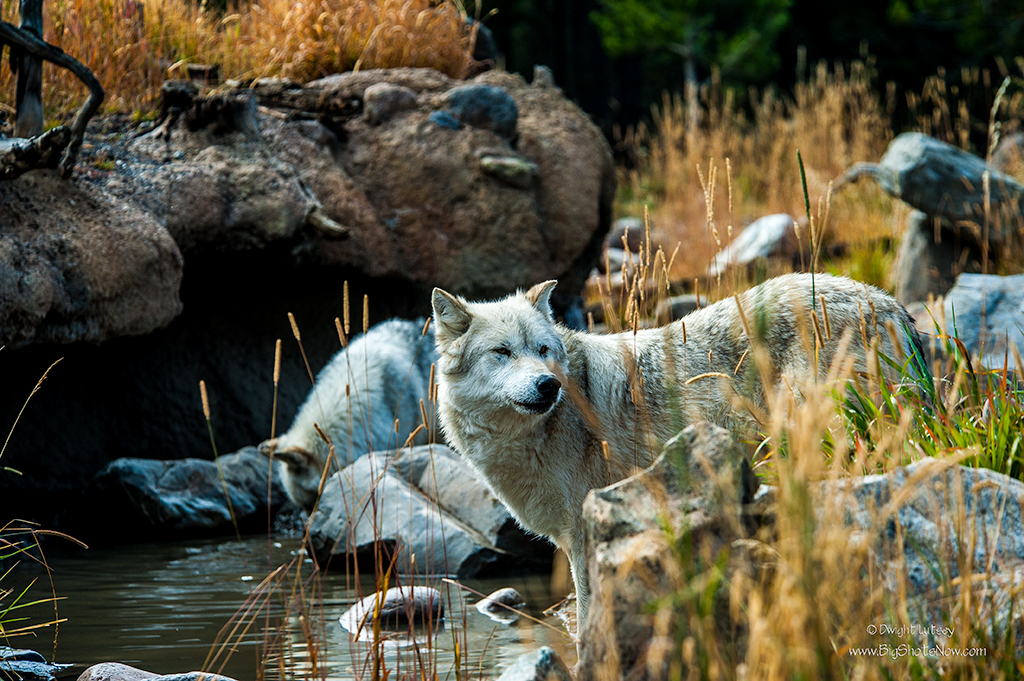As you can see by the above photo there is a new plague troubling our friends the wolves. It’s not just the Wyoming legislature or mean-spirited ranchers but a new disease called lupus prope aciei or Wolf Near-sightedness. It is a relatively new disease for these wolves, only having been discovered after researchers found them stumbling and bumping into things as the wolves tried to follow a scent trail on their hunt. The researchers had been following up reports of wolves with large swollen noses and bruises around their head and shoulders seen sitting listlessly along the roadside. They had taken to walking along the asphalt because of the lack of obstacles in their way, pathetically nose to tail, like tired circus elephants, sometimes the young pups even holding on to their parents tails with their mouths. If wolves could cry it would have been their Trail of Tears.
Just what is this affliction really though, you might ask. Well here you can see a prime example of this problem in action. The wolf in the foreground has just scented an elk or buffalo or a tourist with some pizza and is peering about myopically trying to locate its possible prey. See it squint its eyes, that’s not a Clint Eastwood imitation, no, that is lupus prope aciei at work. That poor wolf can not see past the end of its own snout. The wolf in the background who is also afflicted is desperately trying to ascertain what it is it just stepped in.
The federal government sent in a canine Ophthalmologist to test the wolves hoping to discover the cause of the wolves ailments but due to over-zealousness in the doctor’s approach and his handling of the wolves he was never seen again. These are wolves. They’re near-sighted not domesticated. So as of right now we know little about the cause and/or treatment of this debilitating affliction other than don’t be grabbing no wolf by the nose to look in its eyes unless you get some type of formal agreement first. That, and wolves can’t digest badges and optical testing equipment. It’s not much but it’s a start.
Fortunately or unfortunately, depending on your point of view, these wolves are now safe in a modified enclosure near Yellowstone National Park until they can be cured. All the rocks and other wolf-height lumpy obstacles are in the process of being wrapped in a protective foam covering and other taller impediments such as trees, large shrubbery, shovel handles, barrels to store wolf chow in, etc., are being modified with an application of foam Bollard covers, a technique borrowed from the maritime industry to keep large oil tankers from damaging those expensive metal posts on the docks they tie up at. This may safeguard our wolves for the time being but is not by any means a long-term solution.
One drawback to this approach is that it hasn’t been determined whether wolves like the taste of foam. If that turns out to be the case, that wolves do indeed like the taste of foam, perhaps a solution would be to spray the entire compound with an industrial strength product like Grannick’s Bitter Apple Spray, which is used to keep puppies from eating your credenza, and is available at fine pet stores nationwide. It’s just a thought.
But listen, a word of warning. If you should come across a wolf sitting forlornly along the roadside staring at his feet, don’t rush up to it and offer your condolences about its condition, Wolves don’t like that. Instead in a moderate tone say something like “Hey, dude, What’s up? You OK? Anything we can do for you?” Something like that. Do not and I repeat, Do not rush up and grab its snout and start looking into its eyes to see if it is near-sighted or not. I mean, this should go without saying but there are some of you out there that watch way too much TV and might be tempted to utilize the Disney approach and offer aid. Don’t do that. There are trained professionals on duty to handle situations like this. Call them. Let them do their jobs. Instead if you feel like you want to help, send cards, or donate those used eye glasses into the many drop-off boxes located throughout the area, or make a donation to the lupus prope aciei fund or simply drive on by. You can help more just by sending them your good thoughts.


You must be logged in to post a comment.